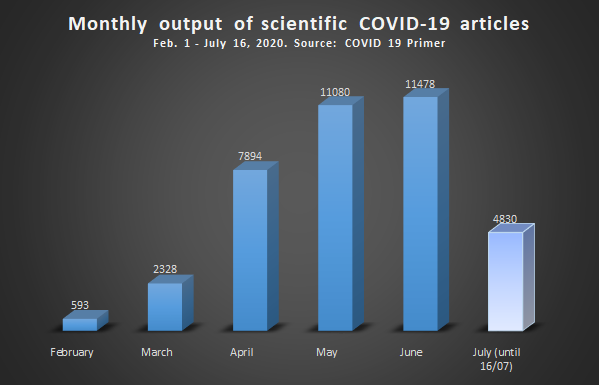Science has an amazing output. But is it doing the right things?
There was a time, back in March – April, when scientific output on COVID-19 resembled a pandemic outbreak. Early April, the number of papers was doubling every 14 days, mid-May still every 20 days. Some expected that science would outpace the virus. This did not happen.
One source for looking into the amount of scientific work the pandemic generated, is the COVID-19 Primer Dashboard, developed by machine intelligence company Primer AI. COVID-19 Primer collects all COVID-19 SARS-CoV-2 research papers published in PubMed-indexed journals or via the preprint servers of bioRxiv, medRxiv and arXiv. The total number of scholarly COVID-19 articles is neatly depicted in a daily updated graph. Based on these data, the figure below gives the monthly number of publications.

Today, the trend of the number of publications over time is clearly no longer exponential, but linear. This is what one would expect. After an induction period, scientific output (following the criteria of COVID-19 Primer) now progresses at a steady, yet frenetic pace of 10,000 – 12,000 papers per month. Hardly a slowdown, but beaten by the global increase of COVID-19 infections, which propagates still in stronger than linear fashion.
COVID-19 Primer counts (July 16) 38,261 papers. CORD-19, a structured dataset developed by several tech giants to help scholars overcome information overload, contains to date even 130,000 articles on the novel virus. This amazing output fuels the optimism that we will soon understand and beat this plague. But is science always doing the right thing?
Here there is reason for concern. Scientists are hastening publications, sometimes overselling preliminary results. Peer reviewing becomes incomplete. This situation prompted Elgendy, Barakat et al. to take a closer look at the type of articles published. The authors searched the Medline database for publications in the period February 1, 2020 – April 20, 2020, containing the keywords “COVID-19” or “corona”.
They have analyzed 4493 articles. Of these 4493, only 22.9% turned out to be original investigations. Opinion articles accounted for 77.1%, almost 3.5 times as many. This trend becomes even more worrying if one considers that the numerous contributions of scientists to social media and newspapers have been left out.
There might be a certain risk of redundant publications, the authors conclude. That seems an understatement. Less drive for scoring and visibility will inevitably free up time for original research. It could lead to less output, but also to better output. I’ll take that risk any day.
For more information:
(rvdk)


Pingback: How artificial intelligence helps to fight the pandemic, and why it is not the solution - The Corona Diaries